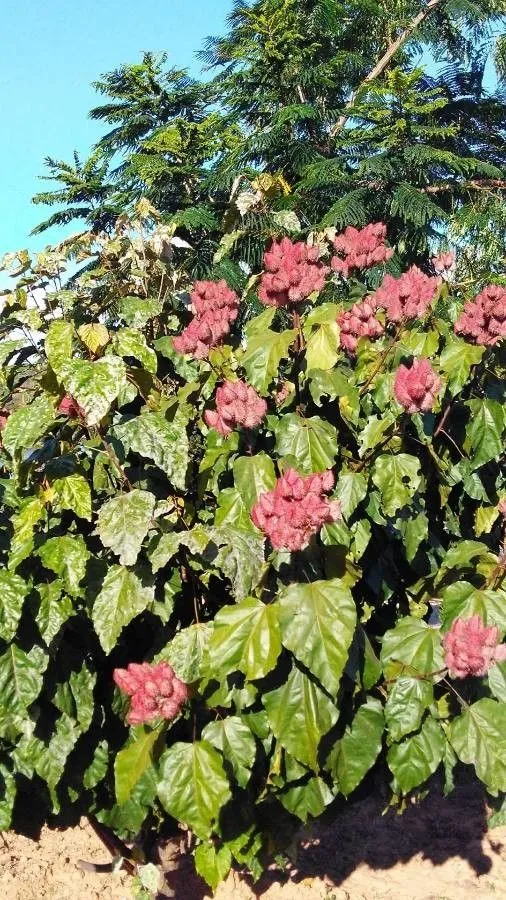
Author: L.
Bibliography: Sp. Pl.: 512 (1753)
Year: 1753
Status: accepted
Rank: species
Genus: Bixa
Vegetable: False
Observations: Mexico to S. Trop. America
Arnatto, scientifically known as Bixa orellana, is a captivating and significant plant found throughout Mexico and extending into South Tropical America. This remarkable species, belonging to the Bixaceae family, was first thoroughly documented in the notable work “Species Plantarum” in 1753 by the renowned botanist Carl Linnaeus, commonly abbreviated as L.
The Arnatto plant is widely appreciated for its vibrant, reddish-orange seeds, which have been utilized for various purposes for centuries. Indigenous cultures in the regions where it naturally occurs have harnessed these seeds primarily for their natural dye. This dye, often referred to as annatto, is prized for its use in coloring foods, textiles, and cosmetics, offering a natural alternative to synthetic options. Additionally, annatto has found a place in the culinary world, imparting both color and a subtle, earthy flavor to a variety of dishes.
Beyond its applications as a dye, Bixa orellana holds cultural and medicinal significance. Traditional medicine practices have utilized different parts of the plant to treat a range of ailments, capitalizing on its purported antioxidant and antimicrobial properties. The plant’s leaves, seeds, and roots have been employed in remedies aimed at combating infections, digestive issues, and respiratory conditions among other uses.
Arnatto is also notable for its distinctive physical appearance. The plant typically presents as a bushy shrub or small tree, adorned with glossy, heart-shaped leaves and clusters of attractive, bright pink or white flowers. These flowers eventually give way to spiky, capsule-like fruits that house the valuable seeds. The hardy nature of Arnatto allows it to thrive in diverse tropical environments, making it a resilient and beneficial component of its native ecosystems.
In summary, Bixa orellana, known commonly as Arnatto, is a multifaceted plant deeply interwoven with the cultural, culinary, and medicinal practices of the regions it inhabits. Celebrated not only for its practical uses but also for its ecological presence, this plant exemplifies the rich natural heritage of Mexico and South Tropical America.
Deu: anattostrauch, orleansstrauch
Eng: lipsticktree, annatto, arnatto, roucou, roucu, rucu
Spa: achiote, achote, annato, annatto, bija
Swe: annatto
Fra: atole, roucou, roucouyer
Por: açafroa, colorau, urucum
Kon: nteki
Khm: ជម្ពូជ្រលក់
En: Arnatto, Lipsticktree, Annatto, Achiote, Woucou, Arnotto, Ghâlughâ, Mo, Roucou, Roucu, Rucu, Annato, Lipstick tree, Urucum, Lipstick plant
Ar: بكسة أورلانية
Bn: দইগোটা
My: ပိုးသီတင်း
Zh: 红木
Cs: Oreláník barvířský
Nl: Orleaanboom
Eo: Bikso orelana
Et: Värvibiksa
Fi: Annatto
Fr: Atole, Roucou, Roucouyer, Arbre à rouge à lèvre, Achiote, Rocou, Rocouyer
Ka: Ორლეანის ხე
De: Orleansstrauch, Anattostrauch, Annattostrauch, Annatto, Orleanstrauch
Gn: Uruku
Ht: Pye roukou
Hi: लटकन
Is: Roðatré
Id: Kesumba keling
It: Annatto, Anotto
Kk: Annato, Аннато, انناتو
Km: ជម្ពូជ្រលក់
Kg: Nteki
Ko: 빅사
Lt: Dažinė urlija
Ml: കുരങ്ങുമഞ്ഞൾ
Fa: درخت آناتو
Pl: Arnota właściwa
Pt: Açafroa, Colorau, Urucum, Urucu, Anato, Açafroa-do-Brasil, Urucú
Pt-br: Açafroeira-da-terra, Colorau, Urucú, Urucú-bravo, Urucum
Qu: Achiwiti
Ru: Аннато
Sg: Lëmbïö
Es: Achiote, Achote, Bija, Annato, Achote., Annatto, Roucou
Su: Galinggem
Sv: Annatto
Tl: Atswete
Zh-tw: 紅木
Ta: வருகமஞ்சள்
Th: คำแสด
Zh-hant: 紅木
Uk: Аннато
Vi: Điều nhuộm
Taken Aug 4, 2022 by Rezende Gustavo (cc-by-sa)
Taken Dec 28, 1994 by Andrew Gagg (cc-by-sa)
Taken May 23, 2021 by more baioni (cc-by-sa)
Taken Mar 6, 2021 by V. Sil Ale (cc-by-sa)
Taken Jun 5, 2021 by Fernando da Luz Schmidt (cc-by-sa)
Taken Mar 30, 2020 by Sébastien TRASBOT (cc-by-sa)
Taken Mar 2, 2022 by Linda Bergamini (cc-by-sa)
Taken Aug 4, 2022 by Rezende Gustavo (cc-by-sa)
Taken Jan 15, 2022 by Charl Gobetz (cc-by-sa)
Taken Jun 5, 2021 by Fernando da Luz Schmidt (cc-by-sa)
Taken Mar 2, 2013 by R. Tournebize (cc-by-sa)
Taken Dec 27, 2021 by Maarten Vanhove (cc-by-sa)
Taken Mar 2, 2013 by R. Tournebize (cc-by-sa)
Taken Aug 6, 2022 by Jean-Gael Barbara (cc-by-sa)
Taken Jun 5, 2021 by Fernando da Luz Schmidt (cc-by-sa)
Taken Mar 2, 2013 by R. Tournebize (cc-by-sa)
Taken Aug 14, 2019 by jean-marc stockman (cc-by-sa)
Taken Sep 27, 2021 by Gómez Ely (cc-by-sa)
Taken Aug 10, 2019 by Brett Bissell someguy (cc-by-sa)
Taken Jan 1, 2015 by Donna Gugger (cc-by-sa)
Taken Jul 29, 2022 by Trap Hers (cc-by-sa)
Taken Oct 11, 2021 by Florentino Julio (cc-by-sa)
Taken Feb 25, 2017 by Tela Botanica − Liliane ROUBAUDI (cc-by-sa)
Taken Sep 20, 2016 by Hugo SANTACREU (cc-by-sa)
Taken Sep 18, 2021 by Melo Carlos Walter (cc-by-sa)
Taken May 28, 2021 by Sébastien TRASBOT (cc-by-sa)
Taken Mar 27, 2021 by Gonzalez Jairo (cc-by-sa)
Taken Feb 25, 2017 by Tela Botanica − Liliane ROUBAUDI (cc-by-sa)
Taken Feb 25, 2017 by Tela Botanica − Liliane ROUBAUDI (cc-by-sa)
Taken Feb 25, 2017 by Tela Botanica − Liliane ROUBAUDI (cc-by-sa)
© copyright of the Board of Trustees of the Royal Botanic Gardens, Kew.
© copyright of the Board of Trustees of the Royal Botanic Gardens, Kew.
© copyright of the Board of Trustees of the Royal Botanic Gardens, Kew.
Growth habit: Tree, Shrub
Family: Myrtaceae Author: (F.Muell.) K.D.Hill & L.A.S.Johnson Bibliography: Telopea 6: 402 (1995) Year: 1995 Status:…
Family: Rubiaceae Author: Pierre ex A.Froehner Bibliography: Notizbl. Bot. Gart. Berlin-Dahlem 1: 237 (1897) Year:…
Family: Sapindaceae Author: Koidz. Bibliography: J. Coll. Sci. Imp. Univ. Tokyo 32(1): 38 (1911) Year:…
Family: Asteraceae Author: A.Gray Bibliography: Pacif. Railr. Rep.: 107 (1857) Year: 1857 Status: accepted Rank:…
Family: Fabaceae Author: Medik. Bibliography: Vorles. Churpfälz. Phys.-Ökon. Ges. 2: 398 (1787) Year: 1787 Status:…
Family: Aspleniaceae Author: (Cav.) Alston Bibliography: Bull. Misc. Inform. Kew 1932: 309 (1932) Year: 1932…